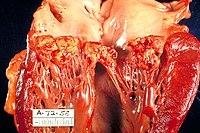
Photo from wikipedia
Objective To define the incidence and risk factors for infective endocarditis (IE) following surgical aortic valve replacement (SAVR) and transcatheter aortic valve implantation (TAVI). Methods All patients who underwent first… Click to show full abstract
Objective To define the incidence and risk factors for infective endocarditis (IE) following surgical aortic valve replacement (SAVR) and transcatheter aortic valve implantation (TAVI). Methods All patients who underwent first SAVR or TAVI in England between 2007 and 2016 were identified from the NICOR databases. Hospital admissions with a primary diagnosis of IE were identified by linkage with the NHS Hospital Episode Statistics database. Approval was obtained from the NHS Research Ethics Committee. Results 2057 of 91 962 patients undergoing SAVR developed IE over a median follow-up of 53.9 months—an overall incidence of 4.81 [95% CI 4.61 to 5.03] per 1000 person-years. Correspondingly, 140 of 14 195 patients undergoing TAVI developed IE over a median follow-up of 24.5 months—an overall incidence of 3.57 [95% CI 3.00 to 4.21] per 1000 person-years. The cumulative incidence of IE at 60 months was higher after SAVR than after TAVI (2.4% [95% CI 2.3 to 2.5] vs 1.5% [95% CI 1.3 to 1.8], HR 1.60, p<0.001). Across the entire cohort, SAVR remained an independent predictor of IE after multivariable adjustment. Risk factors for IE included younger age, male sex, atrial fibrillation, and dialysis. Conclusions IE is a rare complication of SAVR and TAVI. In our population, the incidence of IE was higher after SAVR than after TAVI.
Journal Title: Heart
Year Published: 2022
Link to full text (if available)
Share on Social Media: Sign Up to like & get
recommendations!